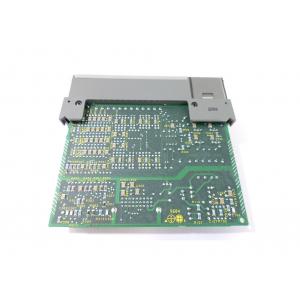AB 1746-NI4 , -20 To +20 MA (Or) -10 To +10V Dc , SLC 500 Analog I/O Module
Add to Cart
AB 1746-NI4 , -20 To +20 MA (Or) -10 To +10V Dc , SLC 500 Analog I/O Module
Technical Specifications for 1746-NI4
| Manufacturer | Rockwell Automation |
| Brand | AB |
| Part Number/Catalog No. | 1746-NI4 |
| Series | SLC 500 |
| Module Type | Analog I/O Module |
| Backplane Current (5 Volts) | 25 milliamps |
| Backplane Current (24 Volts DC) | 85 milliamps |
| Input signal Category | -20 to +20 mA (or) -10 to +10V dc |
| Bandwidth | 10 Hertz |
| Current Input Coding | -16,384 to +16,384 |
| Update Time | 512 microseconds |
| Voltage Input Coding | -32,768 to +32,767 |
| Resolution | 16 bits |
| Chassis location | Any I/O module slot except slot 0 |
| Step Response | 60 milliseconds |
| Backplane Current | (5 Volts) 35 mA;(24 Volts DC) 85 mA |
| Applications | Combination 120 Volts AC I/O |
| Conversion type | Delta–Sigma Modulation |
| Cable Lengths | 0.5, 1, 2.5, or 5.0 meters. |
| Converter Resolution | 16 bit |
| UPC | 662073735908 |
| Repeatability | ±1 LSB |
| UPC | 10662073735905 |
| Non–linearity | 0.01% |
| UNSPSC | 32151705 |
About 1746-NI4
The Allen Bradley 1746-NI4 is an SLC 500 Four (4) Channel Analog Input Module. It has user-selectable analog channels for voltage or current to support multiple monitoring and control applications; it has a 16-bit resolution and contains a removable terminal block that provides connections analog input channel. This channel can be connected as a differential input. There is a DIP that switches on the circuit board to select the input or current voltage. The Backplane current at 5 Volts of this module is 25 mA; at 24 Volts, the current is 85 mA. Caution should be given to avoid connecting the voltage source without the transmitter current, etc. to the channel configured for current input. Incorrect module operation or module damage may occur.
The 1746-NI4 has Standard Cable Lengths of 0.5, 1, 2.5, and 5.0
meters. The AIFM Connector of this module is 15-pin D-shell. The
Allen Bradley 1746-NI4 has Current Loop Input Specifications: the
input range is +/-20 mA (nominal) and +/-30 mA (maximum). The Input
impedance is 250 Ohms with a resolution of 1.22070 & µA per LSB and
an approximate Gain error drift of +/-67 ppm/degrees Celsius. The
overall accuracy at 25 degrees Celsius is +/- 0.365% of full scale,
+/- 0.642% at 60 degrees Celsius. The overall accuracy drift is +79
ppm/degree Celsius of full scale. The 1746-NI4’s input voltage
range is +/-10 Volts DC -1 LSB. Its impedance is 1 mega Ohms. The
accuracy drift is +63 ppm/ degrees Celsius of full scale. The
Resolution is 305.176 & µV per LSB, with a Gain error drift at +/-
57 ppm/degree Celsius. The Overall accuracy at 25 degrees Celsius
is +/-0.284% of full scale, and +/-0.504% at 60 degrees Celsius.
The 1746-NI4 is an analog input module from the SLC 500 series of AB. It features Four (4) differential non-isolated input channels, individually selectable for voltage or current input. Selectable input signals ranges include -20 to +20 mA (or) -10 to +10V dc.
This voltage input is configurable with the use of RSLogix 500
programming software. Using the software, hardware configuration,
data tables and instructions necessary to the operation intended
for the module may be configured and assigned for the analog input
module.
The module operates by converting the analog input signal via the
Delta–Sigma Modulation with range of -16,384 to +16,384 for Current
input and -32,768 to +32,767 for Voltage input. The converted data
may be processed with the use of Scaling algorithm to display the
measured process variable. These scaling is a mathematical formula
that may be implemented manually using arithmetic instructions or
using the Scale with Parameters Block (SCP) instruction provided in
the programming software. Both method produces the same scaled
output.
This module is compatible of being used with a fixed or modular
hardware style SLC 500 controller. The Fixed hardware version of
SLC 500 comes with embedded I/O channels with limited expansion
capabilities. The modular hardware SLC 500 PLC features a fully
modular and customizable system.
This module has built-in LED indicator for indicating the status of
each channel and the overall status of the module’s operation. This
provides quick module diagnostic which may also be accessed via the
controller’s diagnostic interrupt. This system of reporting allows
faster troubleshooting period and increases the availability of the
module.



